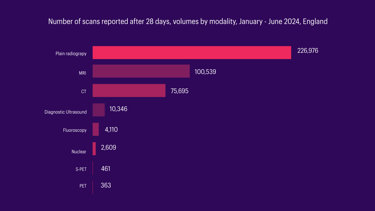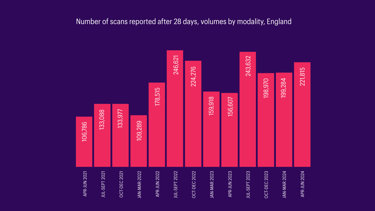New data shows the extent of patients left waiting for crucial scan results
January – June 2024: Turnaround times data release
Large numbers of scans are being reported after 28 days, a result of severe capacity constraints in radiology departments.
- In the first half of 2024 alone, over 420,000 scans were reported more than a month after the acquisition.
- Over 100,000 of these were MRI scans, and over 75,000 CT scans, which are almost exclusively reported by radiologists.


Despite the NHS target for no scan to be reported after 28 days being introduced in August 2023, the data shows no sign of improvement over the past year.
The current target is considered a stepping stone to more ambitious TAT targets in the future – for instance, all scans should be reported within 14 days.

Why is this important?
The data indicate that we do not have sufficient radiologists to report the level of scans that are currently being acquired. This problem will only intensify as demand for scans goes up over the next year.
The Government’s first budget (30th October) recognised the historic underinvestment in NHS capital, and allocated funding for diagnostic scanners and diagnostic centres to bring down waiting lists.
However, the lack of equivalent workforce growth means this investment won’t resolve delays—it will merely shift the bottleneck further along the pathway without accelerating diagnoses.
Capital investment needs to go hand in hand with recruiting, training and retaining the diagnostic workforce we need. Investment in diagnostic services is fundamental to speeding up access to treatment, improving patient outcomes and boosting productivity in the NHS.
Commenting on the latest turnaround times data release, President of The Royal College of Radiologists, Dr Katharine Halliday, said: “Diagnostics underpins so much of what we do in the NHS, but we’re under massive strain. Investing in additional scanners is welcome, but if we want to shift the dial for patients it unfortunately isn’t enough. It is critical that we build capacity in radiology and the best way to do that is by training and retaining radiologists.”